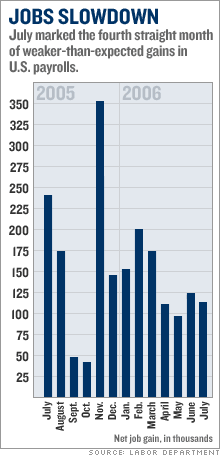Job growth unexpectedly slows Payroll gain of 113,000 misses forecasts for fourth straight month; unemployment rises; wages up. NEW YORK (CNNMoney.com) -- Job growth came in weak for the fourth straight month in July while the unemployment rate rose, according to a government report Friday that could give the Federal Reserve reason to pause in its two-year-old campaign to raise interest rates. The economy added 113,000 jobs in July, the Labor Department said, down from a revised gain of 124,000 jobs in June. Economists surveyed by Briefing.com had forecast 145,000 new jobs.
The unemployment rate unexpectedly rose to 4.8 percent from 4.6 percent. The last time the unemployment rate was this high was in February, the Labor Department said. Economists were expecting no change. While the job market is still growing, the numbers point to a slowdown, according to Robbert Van Batenburg, head of global research at Louis Capital Markets. "It's somewhat of a surprise that both the payrolls and unemployment data show the economy is declining to the extent that it really slows down job creation," he said. The jobs report is the government's first broad look at how the economy did last month, and in the third quarter. Last week the government reported that economic growth slowed to 2.5 percent in the the second quarter, weaker than many economists were expecting, from the first-quarter's blistering 5.6 percent pace. "The report confirms some other evidence showing that the economy is in a slowdown. There's no question about it," said Brian Bethune, U.S. economist for Global Insight. In its report, the Labor Department said that while job growth weakened, wages rose. Average hourly earnings rose 0.4 percent to $16.76 last month, the department said. That was slightly below the 0.5 percent gain in June, but above economists' forecasts for a 0.3 percent rise. "(The rise in wages) could be the only thing in today's data that could stand in way of the Fed stopping its rate-hike policy," Van Batenburg said. While wage growth ticked higher during the month, it moderated on a year-over-year basis to 3.9 percent, down from 3.8 percent in June. Employers have turned cautious in terms of hiring, but it looks like they're asking their employees to work more hours, Bethune said. That's probably resulting in more overtime pay and generating some increases on the wage front, he said. Betting on a pause Wall Street rallied, as investors bet the soft data would give the Fed a reason not to raise rates for the 18th straight time next week to 5.50 percent. Traders are now betting there's a 26 percent chance the Fed will raise rates on Tuesday, down from a 41 percent chance late Thursday. (What will the Fed do?) While a pause may be more likely now, that doesn't necessarily spell an end to rate hikes from the Fed, according to David Joy, chief market strategist for RiverSource Investments, the asset management firm of Ameriprise Financial. "My expectation is for the Fed to pause, but I'm not equating a pause with a stop. They still could raise at some point down the road," he said. And while the economy is slowing, the Fed also has to deal with rising inflationary pressures, economists said. Earlier this week a key inflation gauge - the Commerce Department's PCE deflator - showed core consumer prices, excluding food and energy, rose 2.4 percent over the past year, exceeding the Fed's comfort zone for inflation. "At this point the Fed has to be careful because current policy is going to affect the economy six months down the future. It would be prudent for them to pause to see if the economy continues to see signs of slowing," Global Insight's Bethune said. Before the central bank's policy-makers meet Tuesday, they'll get a look at a report on productivity and unit labor costs. If the report shows a sharp spike in unit labor costs, the chance of a Fed pause could be thrown up in the air again. Productivity has played an important role in offsetting rising wages, and the Fed will be keeping an eye on those numbers, Joy said. And the Fed's next move will be ... |
| |||||||||||||



